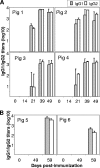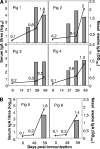Enhanced mucosal immunoglobulin A response and solid protection against foot-and-mouth disease virus challenge induced by a novel dendrimeric peptide
- PMID: 18448530
- PMCID: PMC2446959
- DOI: 10.1128/JVI.00401-08
Enhanced mucosal immunoglobulin A response and solid protection against foot-and-mouth disease virus challenge induced by a novel dendrimeric peptide
Abstract
The successful use of a dendrimeric peptide to protect pigs against challenge with foot-and-mouth disease virus (FMDV), which causes the most devastating animal disease worldwide, is described. Animals were immunized intramuscularly with a peptide containing one copy of a FMDV T-cell epitope and branching out into four copies of a B-cell epitope. The four immunized pigs did not develop significant clinical signs upon FMDV challenge, neither systemic nor mucosal FMDV replication, nor was its transmission to contact control pigs observed. The dendrimeric construction specifically induced high titers of FMDV-neutralizing antibodies and activated FMDV-specific T cells. Interestingly, a potent anti-FMDV immunoglobulin A response (local and systemic) was observed, despite the parenteral administration of the peptide. On the other hand, peptide-immunized animals showed no antibodies specific of FMDV infection, which qualifies the peptide as a potential marker vaccine. Overall, the dendrimeric peptide used elicited an immune response comparable to that found for control FMDV-infected pigs that correlated with a solid protection against FMDV challenge. Dendrimeric designs of this type may hold substantial promise for peptide subunit vaccine development.
Figures




References
-
- Acharya, R., E. Fry, D. Stuart, G. Fox, D. Rowlands, and F. Brown. 1989. The three-dimensional structure of foot-and-mouth disease virus at 2.9 A resolution. Nature 337709-716. - PubMed
-
- Barnard, A. L., A. Arriens, S. Cox, P. Barnett, B. Kristensen, A. Summerfield, and K. C. McCullough. 2005. Immune response characteristics following emergency vaccination of pigs against foot-and-mouth disease. Vaccine 231037-1047. - PubMed
-
- Barnett, P. V., L. Pullen, L. Williams, and T. R. Doel. 1996. International bank for foot-and-mouth disease vaccine: assessment of Montanide ISA 25 and ISA 206, two commercially available oil adjuvants. Vaccine 141187-1198. - PubMed
-
- Barteling, S. J. 2004. Modern inactivated foot-and-mouth disease (FMD) vaccines: historical background and key elements in production and use. Horizon Bioscience, Norfolk, United Kingdom.
-
- Baxt, B., and E. Rieder. 2004. Molecular aspects of foot-and-mouth disease virus virulence and host range: role of host cell receptors and viral factors, p. 145-172. In F. Sobrino and E. Domingo (ed.), Foot-and-mouth disease. Current perspectives. Horizon Bioscience, Norfolk, United Kingdom.
Publication types
MeSH terms
Substances
LinkOut - more resources
Full Text Sources
Other Literature Sources

